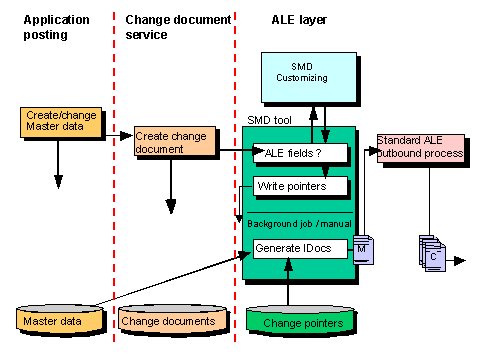点击此处--->
 群内免费提供SAP练习系统(在群公告中)
群内免费提供SAP练习系统(在群公告中)
加入QQ群:457200227(SAP S4 HANA技术交流) 群内免费提供SAP练习系统(在群公告中)
Change Pointer (Master Data Distribution)
Use
If you want to distribute master data changes with the SMD tool (Shared Master Data), changes to the master data objects are flagged for distribution by change pointers ( ® Master Data Distribution).
The SMD tool is connected to the change document interface. If the master data changes are to be distributed, the application writes a change document. The contents of this are passed to the SMD tool. The tool writes change pointers, reads the application data and creates the master IDoc.
The master IDoc is then passed to the ALE layer, which sends it to all interested systems.
The change pointer tables (BDCP und BDCPS) should be as small as possible. Use as few change pointers as possible and delete change pointers which you no longer need.
You can increase the rate of processing by using the Analyze Change Pointer and Reorganize Change Pointer functions.
Prerequisites
You have created change pointers.
Activities
Checklist to keep the change pointer tables as small as possible:
1. Do you really need change pointers?
You need change pointers to distribute changes with the ALE SMD tool. If you do not use this tool, you do not need to write change pointers.
You can deactivate change pointers and activate them again with the transaction BD61.
2. Do you really need to activate change pointers for this messages type?
If some messages types are no longer to be distributed by change pointers, you can
deactivate change pointers for this message type.
You can deactivate change pointers for the message type
and reactivate them again in transaction BD50.
For reduced message types, deactivate the change pointer with the
Reduction tool (transaction BD53).
From NetWeaver Release 6.10, you can restrict the creation of change pointers
in customer exits. This functionality is provided in advance in the
SAP Note 'Reducing the amount of data for change pointers' (0420562).
3. Are there still to many change pointers to be processed?
The change pointers are analyzed with the transaction BD21 or the report RBDMIDOC in ALE
and flagged as processed. If the change pointers
are created periodically, this report should also run periodically.
See also: Analyzing Change Pointers
4. Are no longer required change pointers reorganized in time?
The report RBDCPCLR (transaction BD22) to reorganize the change pointers should
run periodically. Depending on how many change pointers are created or processed,
you can schedule the background job hourly, daily, or weekly.
You should delete all obsolete and processed change pointers.
You can also use this report for specified message types.
See also: Analyzing Change Pointers
Further Information
If you are in a NetWeaver Release 6.X system or higher, use the table BDCP2 for the change pointers, if possible. See the note 'Migrating change pointers to table BDCP2' (0305462).
Distributing Master Data with the SMD Tool
Changes to master data objects are managed using the Shared Master Data (SMD) tool. The SMD tool distributes master data changes to the decentralized systems.
The SMD tool groups changes together according to their content and the time they were changed:
· Firstly, if several changes to a master data object have been made by different SAP transactions and stored in different tables, they are combined into one single change to the master data object.
· Secondly, if several changes are made in close succession, they are also combined into a single change and distributed as one change.

The SMD tool is connected to the change document interface. If the master data changes are to be distributed, the application writes a change document. The contents of this are passed to the SMD tool. The tool writes change pointers, reads the application data and creates the master IDoc.
The master IDoc is then passed to the ALE layer, which sends it to all interested systems.
